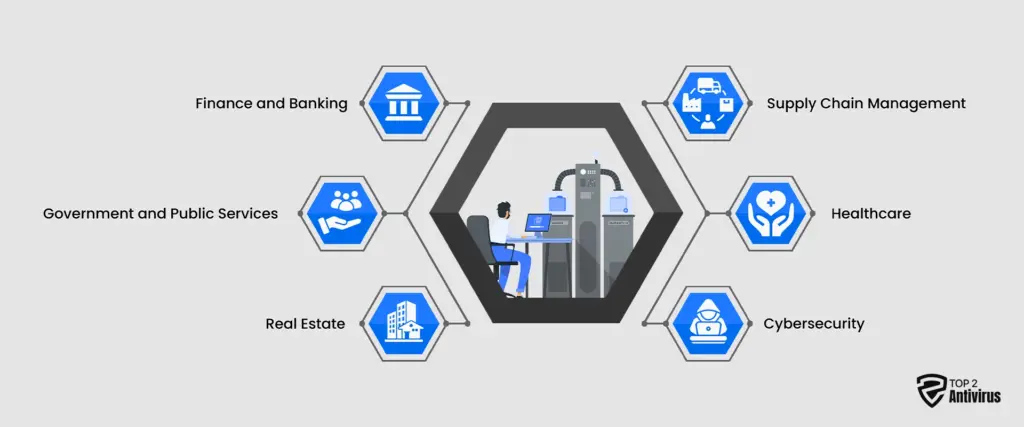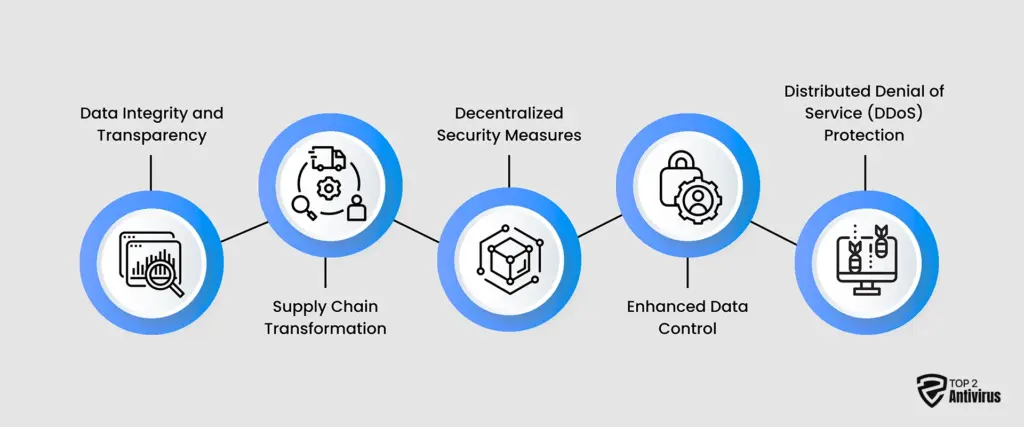
Internet is a treasure mine of information and data. Cyber criminals are looking for one weaklink and you will be under attack. In this 21st century, safeguarding your data is like securing money.
The digital world is full of challenges data breach is one of them. Antimalware tools like Blockchain could be your ultimate defense mechanism. Unlikely, traditional security shields it distributed data into different nodes. These nodes makes data breach almost impossible as hackers can get to the central point of data.
This decentralized approach is a revolutionary step in data protection. Do you still have a doubt about its security approach, then let’s make it clear for you.
Through this article you will learn how block chain is offering comprehensive protection.
What is Blockchain?
Blockchain technology is a game-changing innovation. It acts as a secure, unchangeable database that stores information digitally. It’s a secure, clear, and decentralized ledger. It makes tracking and trading data easy. This is known as Distributed Ledger Technology (DLT). It also streamlined the processes and enhance data security for industries.
Key Features of Blockchain Technology
- Immutability: Once recorded, transactions are unchangeable—no edits, no deletions. This ensures a permanent and tamper-proof record of data.
- Transparency: Transactions are visible to anyone on the network, fostering trust and accountability.
- Security: Blockchain’s decentralized and encrypted process create resilience for hackers.
- Decentralization: Traditional systems controlled by a central authority. Meanwhile, blockchain operates across a network of computers. It reduces the risks of cyber attackers exploiting a single point of failure.
- Distributed Ledgers: They allow every participant to access shared ledgers. These distributed ledgers ensure data integrity across the system.
- Faster Settlement: Blockchain can execute and settle transactions in real time. This significantly reduces delays and the need for intermediaries.
- Encryption: Encrypted data adds another layer of protection. It prevents users from cyber attacks like phishing scams.
- Time and Date Stamping: Every transaction gets a time and date stamp. This creates a full history that you can trace back.
- Unique Identifiers: Every transaction has a unique identifier called a transaction hash. It allows for precise tracking in file storage systems.
Revolutionizing Data Storage for Industries

Blockchain technology has transformed how data is stored, managed, and secured. With features like decentralization, data integrity, encryption, and transparency, it is now a preferred solution for various sectors. Here’s how industries leverage blockchain to enhance cyber operations and protect sensitive information:
1. Finance and Banking
- Use Cases: Secure transactions, cross-border payments, and digital currencies.
- How Blockchain Helps:
- Provides a transparent and tamper-proof ledger for financial transactions.
- Enables faster settlements by eliminating intermediaries.
- Reduces fraud, phishing attacks, and identity theft through encrypted records.
- Supports secure management of cryptocurrency, which is a major use case of blockchain in financial systems.
- Examples: Cryptocurrencies like Bitcoin and Ethereum, and decentralized finance (DeFi) platforms.
2. Supply Chain Management
- Use Cases: Secure supply chain, tracking goods, ensuring authenticity, and reducing fraud.
- How Blockchain Helps:
- Offers end-to-end visibility into the movement of goods.
- Prevents counterfeit products by verifying the origin of goods.
- Enhances collaboration between stakeholders with shared, real-time data.
- Reduces cyber risks through Decentralized threat protection mechanisms.
- Examples: IBM Food Trust, Provenance, and VeChain.
3. Healthcare
- Use Cases: Storing patient records, clinical trial data, and drug traceability.
- How Blockchain Helps:
- Secures sensitive patient data with encryption and access controls.
- Tracks the supply chain of pharmaceuticals to prevent counterfeit drugs.
- Supports real-time sharing of medical information among authorized parties, enhancing data security.
- Empowers threat intelligence and monitoring in healthcare-related cyber operations.
- Examples: MediLedger, Guardtime, and Medicalchain.
4. Government and Public Services
- Use Cases: Land records, voting systems, and identity management.
- How Blockchain Helps:
- Creates a tamper-proof record of land ownership and transactions.
- Enhances transparency and security in electronic voting, protecting against cyber risks.
- Secures citizens’ digital identities in blockchain-backed file storage systems.
- Examples: Estonia’s e-Residency program, West Virginia blockchain voting trials.
5. Real Estate
- Use Cases: Property transactions, ownership records, and smart contracts.
- How Blockchain Helps:
- Ensures transparency and accuracy in property ownership records.
- Reduces the time and costs associated with real estate transactions.
- Automates agreements using smart contracts, minimizing disputes.
- Protects real estate data with secure cyber postures against malicious activity.
- Examples: Propy, Ubitquity, and ATLANT.
6. Cybersecurity
- Use Cases: Data encryption, secure communications, and identity protection.
- How Blockchain Helps:
- Prevents phishing attacks and fraud through encryption and distributed data storage.
- Enhances threat intelligence by tracking suspicious activities.
- Protects sensitive information through Decentralized threat management strategies.
- Reduces reliance on traditional central servers, which are vulnerable to cyber attackers.
- Examples: Chainalysis, CertiK, and Civic.
Blockchain: Unprecedented Security, Transparency, and Trust
Unlike traditional databases that store information, blockchain provides unmatched cyber defense. Here’s what makes blockchain essential:

Data Integrity and Transparency
Blockchain makes data permanent and tamper-proof, which ensures data integrity and authenticity. Here’s how it supports transparency and accountability:
- Immutability: It guarantees a tamper-proof system for file storage systems. Once someone records the data, no one can alter or delete it.
- Real-Time Monitoring: It has ability to record every action and transaction in real-time. It helps with threat analysis. It also speeds up finding cyber risks.
- Enhanced Trust: Transparency allows stakeholders to verify transactions, ensuring trust in the data.
- Accountability: Blockchain records every interaction, creating a complete history for audits.
Supply Chain Transformation
Blockchain has transformed supply chain networks into transparent and secure ecosystems. Key benefits include:
- Smart Contracts: Automated transactions reduce the risk of fraud and counterfeit products.
- Traceability: By tracking the product’s journey, we can ensure a secure supply chain.
- Transparency: Data is accessible to everyone involved. This builds trust and accountability.
- Risk Mitigation: Blockchain prevents unauthorized access to sensitive supply chain data.
- Operational Efficiency: By eliminating intermediaries, blockchain enhances the speed and accuracy of processes.
Decentralized Security Measures: A New Paradigm of Data Protection
Blockchain is secure because it has a decentralized structure. Control is spread out across the network, which protects the data. Key points include:
- No Single Point of Failure: Data spreads across many nodes. This lowers the risk of cyber attacks.
- Verification Process: Blockchain operates on a “never trust, always verify” model. It requiers collective data access or changes agreement.
- Data Integrity: Each action and transaction is checked. This ensures that no rogue entities can compromise the system.
- Decentralized Threat Management: This model ensures a secure cyber posture for organizations. Also reduces the risk of large-scale data breaches.
Enhanced Data Control
Blockchain empowers individuals and organizations with better control over their data. Key advantages include:
- Decentralized Access: Instead of a single authority, multiple nodes verify access requests.
- Reduced Risk of Breaches: The distributed model ensures that sensitive information remains protected.
- Customizable Access: Users can select who can view their data. This helps protect privacy and improves cyber defense.
- Secure File Sharing: Blockchain enables safe and traceable data sharing among authorized parties.
Distributed Denial of Service (DDoS) Protection: Resilient by Design
Blockchain technology offers robust protection against cyber risks such as DDoS attacks. Key features include:
- Decentralized Network: Data and services spread across many nodes. This setup makes it hard for cyber attackers to hit one target.
- Operational Continuity: It ensures operational continuity. If one part of the network gets compromised, the rest remains functional.
- Load Distribution: The network shares data and processing power among nodes. This setup helps reduce the impact of attacks.
- Increased Resilience: Blockchain’s setup makes it tough for cyberattacks to disrupt services.

Why Blockchain Matters: Trust, Security, and Efficiency
Blockchain is not just a trendy term. It’s a strong technology. It changes how we handle digital transactions, secure data, and ensure transparency. It’s not just a new technology. It’s a complete way to improve data security and efficiency. It offers robust defense by leveraging encryption, decentralization, and real-time verification. It introduces modern and advanced protection for data integrity.
Frequently Asked :



